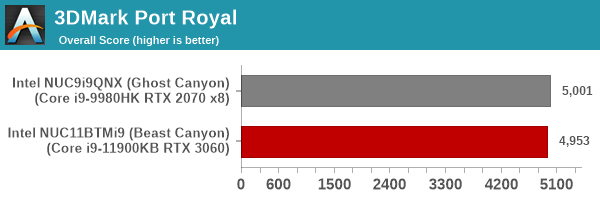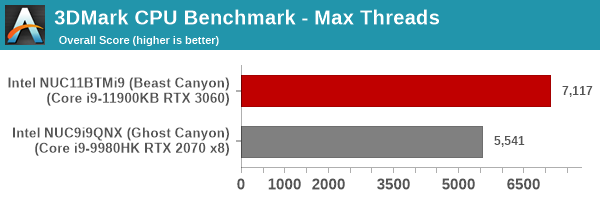Intel Beast Canyon NUC Review: Desktop Tiger Lake Debuts in SFF Gaming Powerhouse
by Ganesh T S on July 29, 2021 9:00 AM EST- Posted in
- Systems
- Intel
- NUC
- Tiger Lake
- NUC11
- Beast Canyon
UL Benchmarks - PCMark and 3DMark
This section deals with a couple of UL Futuremark benchmarks - PCMark 10 and 3DMark. While PCMark evaluates the system as a whole, 3DMark focuses on the graphics capabilities with emphasis on gaming workloads.
PCMark 10
UL's PCMark 10 evaluates computing systems for various usage scenarios (generic / essential tasks such as web browsing and starting up applications, productivity tasks such as editing spreadsheets and documents, gaming, and digital content creation). We benchmarked select PCs with the PCMark 10 Extended profile and recorded the scores for various scenarios. These scores are heavily influenced by the CPU and GPU in the system, though the RAM and storage device also play a part. The power plan was set to Balanced for all the PCs while processing the PCMark 10 benchmark.





3DMark
UL's 3DMark comes with a diverse set of graphics workloads that target different Direct3D feature levels. Correspondingly, the rendering resolutions are also different. We use 3DMark 2.4.4264 to get an idea of the graphics capabilities of the system. In this section, we take a look at the performance of the Intel NUC11BTMi9 (Beast Canyon) across the different 3DMark workloads.
3DMark Ice Storm
This workload has three levels of varying complexity - the vanilla Ice Storm, Ice Storm Unlimited, and Ice Storm Extreme. It is a cross-platform benchmark (which means that the scores can be compared across different tablets and smartphones as well). All three use DirectX 11 (feature level 9) / OpenGL ES 2.0. While the Extreme renders at 1920 x 1080, the other two render at 1280 x 720. The graphs below present the various Ice Storm worloads' numbers for different systems that we have evaluated.
| UL 3DMark - Ice Storm Workloads | |||

3DMark Cloud Gate
The Cloud Gate workload is meant for notebooks and typical home PCs, and uses DirectX 11 (feature level 10) to render frames at 1280 x 720. The graph below presents the overall score for the workload across all the systems that are being compared.

3DMark Fire Strike
The Fire Strike benchmark has three workloads. The base version is meant for high-performance gaming PCs. Similar to Sky Diver, it uses DirectX 11 (feature level 11) to render frames at 1920 x 1080. The Extreme version targets 1440p gaming requirements, while the Ultra version targets 4K gaming system, and renders at 3840 x 2160. The graph below presents the overall score for the Fire Strike Extreme and Fire Strike Ultra benchmark across all the systems that are being compared.
| UL 3DMark - Fire Strike Workloads | |||

3DMark Time Spy
The Time Spy workload has two levels with different complexities. Both use DirectX 12 (feature level 11). However, the plain version targets high-performance gaming PCs with a 2560 x 1440 render resolution, while the Extreme version renders at 3840 x 2160 resolution. The graphs below present both numbers for all the systems that are being compared in this review.
| UL 3DMark - Time Spy Workloads | |||

3DMark Night Raid
The Night Raid workload is a DirectX 12 benchmark test. It is less demanding than Time Spy, and is optimized for integrated graphics. The graph below presents the overall score in this workload for different system configurations.

3DMark Port Royal
UL introduced the Port Royal ray-tracing benchmark as a DLC for 3DMark in early 2019. The scores serve as an indicator of how the system handles ray-tracing effects in real-time.

3DMark CPU Profile Benchmark
UL recently introduced a benchmark to test the multi-threaded capabilities of the CPU in a system. Since gaming workloads are often multi-threaded, it makes sense to include this testing as part of the 3DMark suite. The benchmark routine attempts to perform the simulation of birds / bird-like objects flocking together using as many advanced capabilities as offered by the processor. The workload is configured to run with different number of threads ranging from 1 to 16 (and a single entry for the maximum number of threads allowed in the system).
| UL 3DMark - CPU Profile Benchmark | |||

We present the benchmark results for the single and maximum threads case above.
In almost all workloads, the Beast Canyon outscores other systems heavily. In the case of GPU-bound workloads, the tussle between the RTX 2070 in the Ghost Canyon and the RTX 3060 in the Beast Canyon is too close to call.










84 Comments
View All Comments
Spunjji - Friday, July 30, 2021 - link
The original "Next Unit of Computing" was specifically meant to be an extremely small (below ITX sized) system that was significantly smaller than could be assembled by an end-user from off-the-shelf parts - not just an "SFF desktop".Kaby G was a stretch, but it was still as small as you could get for the power. As notashill noted this one is way, way past that goal. They're free to dilute their branding if they want to, but that's absolutely what they're doing here.
Tams80 - Sunday, August 8, 2021 - link
Eh. Is it really offering anything unique that is hard (too hard) for an average person to bodge together on their own from off the shelf parts?No, it isn't. The other NUCs so far have been something you couldn't just buy the components for and assemble with no skill in perhaps an hour.
mode_13h - Monday, August 9, 2021 - link
> Is it really offering anything unique that is hard (too hard) for> an average person to bodge together on their own from off the shelf parts?
Please show me where I can find a Tiger Lake-H CPU and motherboard, off-the-shelf. You can't because it's BGA-only.
> The other NUCs so far have been something you couldn't just buy the components
> for and assemble with no skill in perhaps an hour.
Because (like this!) they use laptop parts in a (compact) desktop enclosure.
In this case, the only real exception is the GPU. And the fact that it's on a regular graphics card is a feature, since that makes it upgradable.
defaultluser - Thursday, July 29, 2021 - link
Yeah, they even phoned-in the case design - it's exactly the same look as a Cougar QBX.https://www.newegg.com/p/N82E16811553020?quicklink...
powerarmour - Thursday, July 29, 2021 - link
Exactly, I'm struggling to see any genuine innovation here, at least it was fun seeing what they could cram into 1.2L, now they might as well rebrand Alienware boxes and call it a day.Apple will have M2 ready soon, and here we have another generic 5L bread bin with a 650W PSU.
Spunjji - Friday, July 30, 2021 - link
Oh neat - a new case to look at next time I do an SFF build. Thanks!beginner99 - Thursday, July 29, 2021 - link
Fully agree. You can get smaller sff pc cases than this and put similar components in it. The NUC has been about not being able to build such a small thing yourself because it was essentially custom.damianrobertjones - Friday, July 30, 2021 - link
'Next Unit of Computing'.Nowhere does it state that they have to be small.
powerarmour - Friday, July 30, 2021 - link
And toilets don't have to be bowl shaped either... there's a clear inference (after eight generations at least) that these things should be small and compact.Wrs - Saturday, July 31, 2021 - link
It does remove a lot of the purpose for buying it when any old SFF case can house the same components without locking you to Intel cards